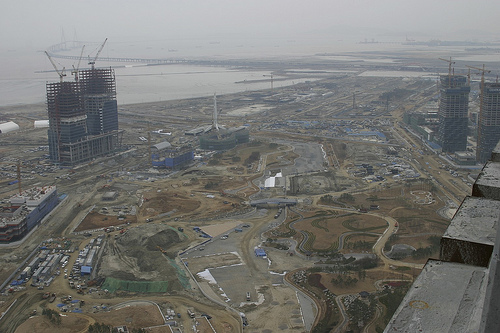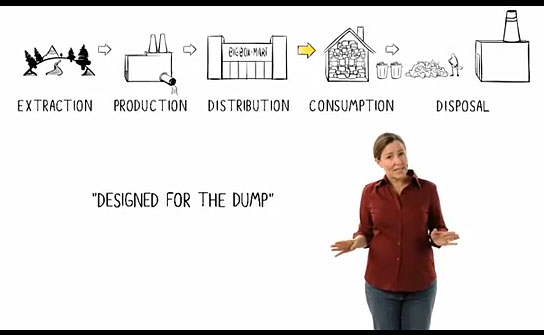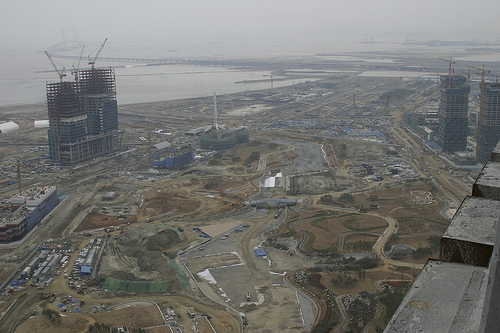 New Songdo City, rising from reclaimed land near Incheon, South Korea, is slated to have 252,000 inhabitants.Photo: Nicolette MastrangeloSo-called smart cities — places where energy systems, water treatment, transportation, and other infrastructure elements are digitally coordinated for maximum efficiency — got the Economist treatment last week. In a special report, the magazine discussed the proliferation of built-from-scratch, totally wired municipalities, including Masdar in the United Arab Emirates, New Songdo City in South Korea, and PlanIT Valley (could the name be any worse?) near Porto, Portugal.
New Songdo City, rising from reclaimed land near Incheon, South Korea, is slated to have 252,000 inhabitants.Photo: Nicolette MastrangeloSo-called smart cities — places where energy systems, water treatment, transportation, and other infrastructure elements are digitally coordinated for maximum efficiency — got the Economist treatment last week. In a special report, the magazine discussed the proliferation of built-from-scratch, totally wired municipalities, including Masdar in the United Arab Emirates, New Songdo City in South Korea, and PlanIT Valley (could the name be any worse?) near Porto, Portugal.
Now, don’t get me wrong, I believe that smart grids of all kinds are a vital part of a sustainable urban future. And cities like Masdar and PlanIT Valley might well serve as laboratories for the development of these technologies. It’s exciting to see that real estate developers and governments are taking the sustainability challenge seriously.
But.
First, both Masdar and PlanIT Valley are greenfields developments. New Songdo City will be built on a manmade island, on land reclaimed from the Yellow Sea. Constructing these places inevitably means a huge expenditure of natural resources.
The financing involved in creating such enormous developments is also tricky, especially in today’s volatile economic climate. New Songdo City is projected to cost as much as $40 billion to build. Here’s what The Independent had to say about that:
Like most grandiose schemes, Songdo is suspended above a featherbed of confidence, and debt. [New York-based real estate company Gale International] has gone billions into the red to build its state-of-the-art showcase. The 65-floor Northeast Asia Trade Tower, which will be Korea’s tallest building when complete, has been re-financed, and main lender Shinhan Bank, in the words of one insider, “shuddered” when the global economic crisis hit Korea.
These cities will also be home to controlled populations. In the case of Masdar, the government owns it — and will decide who gets to live there. PlanIT Valley is destined to be essentially a company town, whose eventual 150,000 inhabitants will be the employees of the corporate entities that are partnering to build the place, such as Cisco and Accenture, and their families. New Songdo City’s homes have an average price of $500,000 — evidently the workers who groom the 7,300-yard golf course, designed by Jack Nicklaus, will be living elsewhere.
And that raises the next question: Are such tightly controlled environments what we currently understand as cities at all? Will they ever take on personalities? Will they ever be loved?
It’s not an idle question. As was discussed in a recent issue of Nature, cities are places where innovation happens. But that’s not because they are controlled technological environments filled with people filtered by income, or employed by a constellation of tech corporations, no matter how advanced and enlightened.
No, cities are what they are because they are containers for difference — places where people and ideas bump into each other, where assumptions are constantly challenged, where classes and attitudes rub shoulders and jostle each other, and the whole is much more than the sum of its parts.
On a recent edition of Radiolab, hosts Jad Abumrad and Robert Krulwich talked to scientists who have tried to find a link between the way time is perceived in a city — as measured by the walking pace of its residents — and just about anything else you can imagine. They have, in effect, searched for a way to quantify cities.
What they’ve discovered is that there is a correlation between how quickly a city’s citizens walk and how many patents it produces, or how many libraries it has, and so forth.
It’s a neat parlor trick, and well worth your listening time (love you, Radiolab!). But as the researchers themselves admit, there is no formula for measuring the “New Yorkness” of New York — or the Duluthness of Duluth, for that matter.
So how do we make cities smarter (in the sustainability sense) without building a world of sterile, personality-challenged municipalities from the ground up? How do we fix broken places like Jakarta, where flooding recently caused traffic jams that lasted for up to 10 hours, or Baltimore, where blocks and blocks of rowhouses stand empty? How do we practice what some have called retrofit urbanism?
Rebuilding and reimagining of the places that are already there, the cities we already love, makes more sense in sustainability terms than the heavily leveraged construction of futuristic utopias. The cities of today can become the cities of tomorrow, while retaining their distinctive characters. In fact, there’s probably no way they can succeed without strengthening and building those characters, rather than looking for solutions off the shelf of some urban laboratory.
As Aaron Renn at The Urbanophile puts it:
Great cities, like great wines, have to express their terroir. There is no one-size-fits-all model of urban success.
Fortunately there are a lot of smart people working on the smart cities idea who get it.
A growing cohort of visionaries and hackers is working on a variety of urban problems, especially in the transportation and infrastructure realm, by building tools to make cities work better using open-source software and open data. One of the strongest to emerge is SeeClickFix, which is helping citizens identify, report, and fix problems in their cities, from potholes to broken streetlights. From their mission statement:
Imagine a world where every citizen feels empowered and part of their neighborhood. Imagine if everyone trusted and felt taken care of by their local government. We know there are already a lot of involved citizens and hard-working local authorities and service people. We seek to use the power of the internet to bring them closer together and reach even more people….
A few local governments have enough sophistication to run functional websites or 311 hot lines. Most do not have the resources to do much more than brochure-ware. Our site is a place for citizens from anywhere to give their local government a website that tracks local issues. No set-up time. No hiring consultants to study the issue. Just SeeClickFix.
Small projects like NYC Big Apps, the Great Urban Hack, and DIY City are springing up everywhere. Are they enough to change urban landscapes for the better? No, not yet.
But on a larger scale, IBM and its Smarter Cities campaign is looking to foster innovative solutions to problems “in areas as diverse as transportation, energy, clean water, education, social services, public safety and economic development,” not by building new cities, but by working with ones that exist already. Just yesterday, the company announced its Smarter Cities Challenge:
The Smarter Cities Challenge, a competitive grant program, will provide consulting and technology assistance valued at $50 million over the next three years to 100 cities worldwide (50 in North America; 50 elsewhere)…. Cities have tremendous opportunities to use data, connectivity, and sophisticated software tools to know themselves better and improve their efficiency and effectiveness as providers of services and engines of economic growth. The company has launched pilots in Baltimore, Austin, and Charlotte.
When it comes to the cities of the future, sustainability needs more than just purpose-built models like Masdar, New Songdo City, and PlanIT Valley. Imagine if the resources used to force these places into being were instead channeled into existing cities, which need the help so desperately. That would be truly smart.




